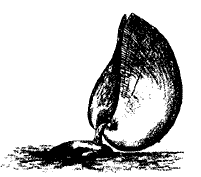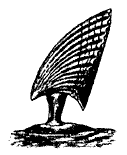
Platystrophia
Late Ordovician- period
illustration from Fenton & Fenton, The Fossil Book, 1958, Doubleday & co., p.120
| Rhynchonelliformea | ||
| Brachiopoda | Orthida |
| Metazoa | |||

The orthid brachiopods were the first important articulate group to diversify, and appeared during the Early Cambrian period, and became very diverse during the Ordovician. They are typically strophic having a straight hinge line), and well developed interareas. Radiating ribs are also common in this group, as are sulcus and fold structures. Usually one valve (usually the brachial valve) is flatter than the other. The cardinalia (structures in the interior of the brachial valve) of orthids are usually simple. The shape is sub-circular to elliptical with the valves generally biconvex.
The orthids began with small subquadrate forms during the early and middle Cambrian. There is some controversy now over whether many of these early types really were Orthids at all, or should be separated into a distinct Order, or even, in recent classification systems, a different class. I have followed the classification scheme in use by EuroBrachNet and the revised Treatise of Invertebrate Paleontology, and transferred the better known of these early primitive forms to different orders and classes. Whether this arrangement will still be in use in future years and decades, or a totally different view of early brachiopod phylogeny will be adopted, remains to be seen.
An apparently early modification in the late Early Cambrian gave rise to the more characteristic orthaceans in which the delthyrium and notothyrium are open. This implies that a pedicle rudiment was developed as a primary segment of the larva as in modern articulates. The orthaceans again have a fibrous secondary shell and are presumed to have arisen from some nisuisid stock, possibly by paedomorphic changes affecting pedicle development in particular.
By the Furongian Epoch orthids and orthid-like brachiopods achieved considerable variety and widths of 2 to 5 cm. Furongian and earliest Ordovician genera included shells with rounded to high, pointed pedicle valves, sharp to obtuse extremities, and fine to coarse ridges (called costae).
During the mid-Ordovician, punctate shells appeared, establishing the suborder Dalmanellidina (the superfamily Enteletacea of the Treatise of Invertebrate Paleontology). Both the Orthodina and Dalmanellidinar suborders then gave rise to a great variety of genera and species, some of which resembled members of the other suborder and even of different orders. One Ordovician orthid looked like a strophomenid, and Productorthis developed both shape and ornamentation which were paralleled during the later Paleozoic by the spiny productids. Platystrophia anticipated the spirifers in both shape and habit and even went through similar changes in the evolution of its species.

Platystrophia
Late Ordovician- period
illustration from Fenton & Fenton, The Fossil Book, 1958, Doubleday & co., p.120
The Orthids were greatly reduced by the end Ordovician extinction event, although both impuncate and puncate Orthids continued through to the early Devonian. At that time the impunctate types died out, but the punctate Dalmanellidina continued on. These sometimes resembled morphotypes of earlier Orthodina. Schizophoria, of Devonian age, resembles the mid-Ordovician Hebertella. The punctate Orthids continued as a minor element of the benthic fauna until the end of the Permian.

On the left is the classification according to the Treatise on Invertebrate Paleontology. On the right is the newer classification by EuroBrachNet, which divides the old category of Orthids into several distinct, even unrelated orders
| Treatise on Invertebrate Paleontology | Classification des Brachiopoda | |
ORTHIDA |
Class Strophomenata Billingsellida |
not Orthids |
| Class Rhynchonellata PROTORTHIDA Protorthoidea (Early Cambrian-Late Devonian) Skenidoidea (Lower Ordovician-Upper Devonian) |
Orthid relatives |
|
| ORTHIDA Orthodina Orthoidea (Middle Cambrian-Early Devonian) Plectorthoidea (Early Cambrian-Late Silurian) Dalmanellidina Dalmanelloidea (Early Ordovician-Late Devonian) Enteletoidea (Middle Ordovician-Late Permian) |
Orthids | |
 Brachiopoda main page |